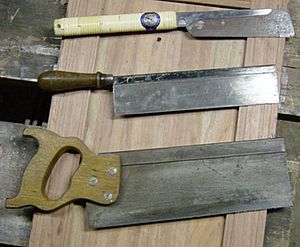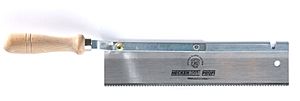Backsaw facts for kids
A backsaw is a special type of hand saw used for very careful and accurate cuts in woodworking. What makes it unique is a strong, stiff rib along the top edge of the blade. This rib helps the saw stay straight and steady, giving you much better control than other saws.
Backsaws are often used for detailed jobs like making special wood joints. These include dovetail joints, miter joints (angled cuts), or tenons (parts of a joint). They are popular in cabinetry and joinery, where precision is key. Because of the stiffening rib, backsaws can't cut super deep. They usually have many small teeth that are close together, which helps make clean, smooth cuts.
Types of Backsaws
There are several kinds of backsaws, each designed for different tasks. Some common ones are the tenon saw, the dovetail saw, and the sash saw. Many backsaws have a handle shaped like a pistol grip, which can be open or closed at the bottom.
Here are some different types of backsaws:
- Mitre saw – This is a large backsaw, often 20 to 30 inches (60–90 cm) long. It's used with a special wooden or metal mitre box to make cuts at exact angles. While some mitre saws are backsaws, electric mitre saws are more common today.
- Tenon saw – This is a medium-sized backsaw. It gets its name because it's used to cut tenons for mortise and tenon joints. Tenon saws can have teeth designed for cutting along the wood grain (rip-filed) or across it (cross-cut). They usually have fine teeth, often around 13 teeth per inch.
- Sash saw – In the past, this was a smaller tenon saw used to build window sashes (the frames that hold window panes). Today, the term can also mean a thin, flexible saw used to free windows that are stuck from paint.
- Carcass saw – This saw is a size between a tenon saw and a dovetail saw. It's good for general woodworking tasks.
- Dovetail saw – This is a small backsaw specifically used to cut dovetail joints. These saws have even finer teeth, usually 15 to 20 teeth per inch. Their teeth are sharpened for rip cutting, but they also work well for cutting across the wood grain.
- Gent's saw or Gentleman's saw – This is a small dovetail saw with a straight, turned handle. It's often used for very small woodworking projects, like making parts for musical instruments, dolls' furniture, or other model-making. Its small size and unique handle are its main features.
- Razor saw – A very tiny backsaw with extremely fine teeth, often with no "set" (meaning the teeth don't stick out much). Hobbyists, especially those building model aircraft, boats, or model railroads, use razor saws. These saws often have disposable blades because their teeth are too small to sharpen. Razor saws make very clean cuts in soft woods like Balsa and can also cut plastics and soft metals.
- Dōzuki – This is a Japanese backsaw that has been used for centuries by Japanese carpenters. Unlike Western backsaws, the dōzuki cuts when you pull it towards you, not when you push. This "pull stroke" allows for straighter and thinner cuts because the blade is under tension during the cut, so it doesn't need to be as thick to stay straight.
How Backsaws Are Designed
A backsaw needs a blade that is both thin and strong. To achieve this, a stiff metal cap, usually made of brass or steel, is attached along the top edge of the blade. This cap is called the "back." The stiffening back extends into the handle, making sure the blade doesn't bend. The back limits how deep the saw can cut, but this isn't usually a problem for the precise jobs backsaws are used for.
Tools Used with Backsaws
Backsaws are often used with other tools to help with accuracy:
- A mitre box is often used with a backsaw to help make cuts at exact angles.
- A bench hook is another helpful accessory. It holds the wood steady while you saw.
- A marking knife is also commonly used. It makes a very clean line on the wood, much better than a pencil. This cut line helps prevent the saw from tearing the wood fibers, leaving a smooth edge.
See also
 In Spanish: Serrucho de costilla para niños
In Spanish: Serrucho de costilla para niños



